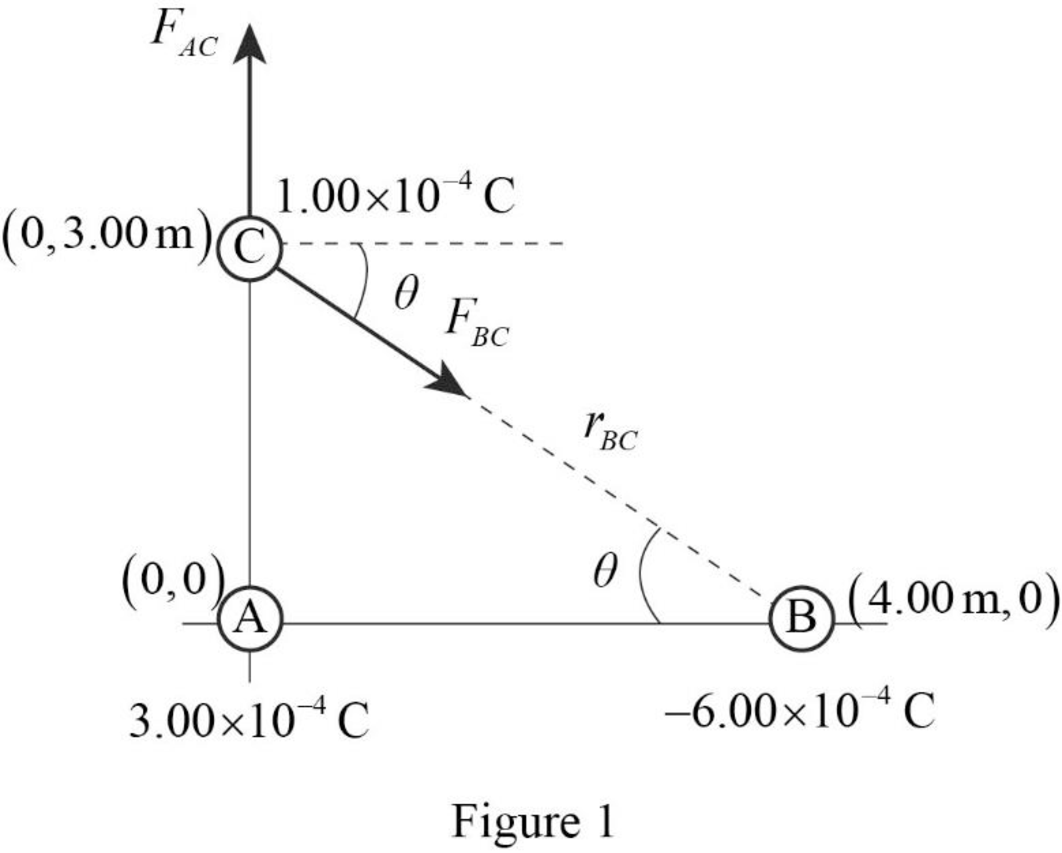
Concept explainers
Particle A of charge 3.00 × 10–4 C is at the origin, particle B of charge –6.00 × 10–1 C is at (4.00 m, 0), and particle C of charge 1.00 × 10–4 C is at (0, 3.00 in). We wish to find the net electric force on C. (a) What is the x component of the electric force exerted by A on C? (b) What is the y component of the force exerted by A on C? (c) Kind the magnitude of the force exerted by B on C. (d) Calculate the x component of the force exerted by B on C. (e) Calculate the y component of the force exerted by B on C. (f) Sum the two x components from parts (a) and (d) to obtain the resultant x component of the electric force acting on C. (g) Similarly, find the y component of the resultant force vector acting on C. (h) Kind the magnitude and direction of the resultant electric force acting on C.
(a)
The
Answer to Problem 10P
The
Explanation of Solution
Figure 1 represents the three charges A, B, and C, and the three charges are arranged in such a way that charge C is attracted by charge B, and repelled by charge A.

The distance between charge A and C is
Write the distance between charge C and B from Figure 1.
Write the angle between the horizontal and
Write the expression for component of electric force exerted by charge A on charge C.
Here,
The
Conclusion:
Therefore, the
(b)
The
Answer to Problem 10P
The
Explanation of Solution
The
Write the expression for
Here,
Conclusion:
Substitute
Therefore, the
(c)
The magnitude of electric force exerted by charge B on charge C.
Answer to Problem 10P
The magnitude of electric force exerted by charge B on charge is
Explanation of Solution
Write the expression for electric force exerted by charge B on charge C.
Here,
Conclusion:
Substitute
Therefore, the magnitude of electric force exerted by charge B on charge is
(d)
The
Answer to Problem 10P
The
Explanation of Solution
From subpart (b) the magnitude of force exerted by charge B on charge C is
Write the expression for
Here,
Conclusion:
Substitute
Therefore, the
(e)
The
Answer to Problem 10P
The
Explanation of Solution
From subpart (b) the magnitude of force exerted by charge B on charge C is
Write the expression for
Here,
Conclusion:
Substitute
Therefore, the
(f)
The sum of
Answer to Problem 10P
The sum of
Explanation of Solution
Write the expression for sum of
Here,
Conclusion:
Substitute
Therefore, The sum of
(g)
The sum of
Answer to Problem 10P
The sum of
Explanation of Solution
Write the expression for sum of
Here,
Conclusion:
Substitute
Therefore, the sum of
(h)
The magnitude and direction of the resultant electric force acting on charge C.
Answer to Problem 10P
The magnitude of the resultant electric force acting on charge C is
Explanation of Solution
Write the expression for magnitude of resultant electric force acting on charge C.
Here,
Write the expression for direction of the resultant electric force acting on charge C.
Here,
Conclusion:
Substitute
Substitute
Therefore, The magnitude of the resultant electric force acting on charge C is
Want to see more full solutions like this?
Chapter 19 Solutions
Principles of Physics: A Calculus-Based Text
- pls help on all asked questions kindlyarrow_forward19. Mount Everest, Earth's highest mountain above sea level, has a peak of 8849 m above sea level. Assume that sea level defines the height of Earth's surface. (re = 6.38 × 106 m, ME = 5.98 × 1024 kg, G = 6.67 × 10 -11 Nm²/kg²) a. Calculate the strength of Earth's gravitational field at a point at the peak of Mount Everest. b. What is the ratio of the strength of Earth's gravitational field at a point 644416m below the surface of the Earth to a point at the top of Mount Everest? C. A tourist watching the sunrise on top of Mount Everest observes a satellite orbiting Earth at an altitude 3580 km above his position. Determine the speed of the satellite.arrow_forwardpls help on allarrow_forward
- pls help on allarrow_forward6. As the distance between two charges decreases, the magnitude of the electric potential energy of the two-charge system: a) Always increases b) Always decreases c) Increases if the charges have the same sign, decreases if they have the opposite signs d) Increases if the charges have the opposite sign, decreases if they have the same sign 7. To analyze the motion of an elastic collision between two charged particles we use conservation of & a) Energy, Velocity b) Momentum, Force c) Mass, Momentum d) Energy, Momentum e) Kinetic Energy, Potential Energyarrow_forwardpls help on all asked questions kindlyarrow_forward
- pls help on all asked questions kindlyarrow_forward17. Two charges, one of charge +2.5 × 10-5 C and the other of charge +3.7 × 10-6 C, are 25.0 cm apart. The +2.5 × 10−5 C charge is to the left of the +3.7 × 10−6 C charge. a. Draw a diagram showing the point charges and label a point Y that is 20.0 cm to the left of the +3.7 × 10-6 C charge, on the line connecting the charges. (Field lines do not need to be drawn.) b. Calculate the net electric field at point Y.arrow_forward3arrow_forward
 Physics for Scientists and Engineers: Foundations...PhysicsISBN:9781133939146Author:Katz, Debora M.Publisher:Cengage Learning
Physics for Scientists and Engineers: Foundations...PhysicsISBN:9781133939146Author:Katz, Debora M.Publisher:Cengage Learning Principles of Physics: A Calculus-Based TextPhysicsISBN:9781133104261Author:Raymond A. Serway, John W. JewettPublisher:Cengage Learning
Principles of Physics: A Calculus-Based TextPhysicsISBN:9781133104261Author:Raymond A. Serway, John W. JewettPublisher:Cengage Learning College PhysicsPhysicsISBN:9781305952300Author:Raymond A. Serway, Chris VuillePublisher:Cengage Learning
College PhysicsPhysicsISBN:9781305952300Author:Raymond A. Serway, Chris VuillePublisher:Cengage Learning College PhysicsPhysicsISBN:9781285737027Author:Raymond A. Serway, Chris VuillePublisher:Cengage Learning
College PhysicsPhysicsISBN:9781285737027Author:Raymond A. Serway, Chris VuillePublisher:Cengage Learning
 Physics for Scientists and Engineers, Technology ...PhysicsISBN:9781305116399Author:Raymond A. Serway, John W. JewettPublisher:Cengage Learning
Physics for Scientists and Engineers, Technology ...PhysicsISBN:9781305116399Author:Raymond A. Serway, John W. JewettPublisher:Cengage Learning





